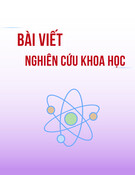
Tran Xuan Vu, Le Quoc Chơn / Tạp chí Khoa học và Công nghệ Đại học Duy Tân 4(47) (2021) 45-53
45
*Corresponding Author: Le Quoc Chon; Faculty of Pharmacy, Duy Tan University, Da Nang, 550000, Vietnam,
Institute of Research and Development, Duy Tan University, Da Nang, 550000, Vietnam
Email: lequocchon@dtu.edu.com
A Review on Current Status of Urban Air Pollution in
Ho Chi Minh city and Ha Noi
Hiện trạng ô nhiễm môi trường không khí trong đô thị tại
thành phố Hồ Chí Minh và Hà Nội
Tran Xuan Vua,b, Le Quoc Chona,b*
Trần Xuân Vũa,b, Lê Quốc Chơna,b*
aDepartment of Environment and Natural Science, Duy Tan University, Danang, 550000, Vietnam
aKhoa Môi trường và Khoa học Tự nhiên, Trường Đại học Duy Tân, Đà Nẵng, Việt Nam
bInstitute of Research and Development, Duy Tan University, Da Nang, 550000, Vietnam
bViện Nghiên cứu và Phát triển Công nghệ Cao, Trường Đại học Duy Tân, Đà Nẵng, Việt Nam
(Ngày nhận bài: 5/5/2021, ngày phản biện xong: 23/6/2021, ngày chấp nhận đăng: 20/8/2021)
Abstract
Air pollution is getting worse in Viet Nam in recent years, particularly in big cities. The most important source of
pollution are traffic and industrial activities. This paper reviews air pollution situation in Ho Chi Minh city and Ha Noi.
We also recommend policies to tackle the problem: (i) upgrade the national air quality standard, (ii) install systematic
and high-quality network of monitor stations, and (iii) remove means of transport that unmet emission regulations.
Keywords: urban air pollution in Viet Nam; air pollution Ha Noi; air pollution Ho Chi Minh city.
Tóm tắt
Ô nhiễm không khí ngày càng trở nên nghiêm trọng tại Việt Nam, đặc biệt là tại trung tâm các đô thị lớn. Nguồn gây ô
nhiễm chính là do hoạt động giao thông và công nghiệp. Bài báo này tổng quan hiện trạng ô nhiễm không khí tại thành
phố Hồ Chí Minh và Hà Nội. Chúng tôi cũng đề xuất một số giải pháp hành chính có thể thực hiện để giảm ô nhiễm
không khí: (i) nâng chuẩn chất lượng môi trường không khí, (ii) xây dựng một cách có hệ thống các trạm đo đạc chất
lượng không khí, (iii) loại bỏ các phương tiện tham gia giao thông không tuân thủ chuẩn chất lượng khí thải.
Từ khóa: Ô nhiễm không khí đô thị tại Việt Nam; ô nhiễm không khí ở Hà Nội; ô nhiễm không khí ở thành phố Hồ Chí
Minh.
1. Introduction
Clean air contains mainly molecular
nitrogen, oxygen, water, argon, carbon dioxide
and very low concentration of other gases as
reported in table 1. However, economic
development, urbanization, transportation,
industrial activity and natural phenomena may
inhibit people around the world, especially in
urban area, from enjoying clean air, which is
contaminated by excessive amount of toxic
gases such as carbon monoxide, nitrogen
dioxide, nitric oxide, ozone, sulfur dioxide and
4(47) (2021) 45-53

Tran Xuan Vu, Le Quoc Chơn / Tạp chí Khoa học và Công nghệ Đại học Duy Tân 4(47) (2021) 45-53
46
hydrocarbon as well as metal and particulate
matter (PM). Indeed, air pollution is a major
concern in many countries such as India [1] and
China [2].
Table 1. Gaseous composition of clean, dry
atmosphere [3].
Air pollution damages both people health
and the economy. World Health Organization
(WHO) reported that air pollution affects all
countries and one out of nine deaths is
associated with air pollution [4]. Similarly, the
Institute for Health Metrics and Evaluation
reported that air pollution is among the top risk
factors leading to death (figure 1) [5].
Figure 1. Air pollution is among the most deathly risky
factors [5].
Even though the direct causal relationship
between mortality rate and ambient air
pollution has not been fully established,
epidemiological studies have confirmed that
ambient air pollution is an important
contributor to high mortality rate [6]. It is
reported that ambient air pollution has annually
caused 4.2 million deaths worldwide, while
household air pollution caused 2.8 million [7].
It is estimated that by 2060 ambient air
pollution will cause between 6 to 9 million
deaths per year. Polluted air, by the same token,
has also led to many serious diseases and the
most common are respiratory infection, chronic
obstructive pulmonary disease, heart disease
and stroke, and lung cancer [7].
Air pollution also induced huge economic
losses, estimated to be US$21 billion globally
expressed in terms of healthcare cost in 2015
and this number is projected to be US$176
billion in 2060 [8].
Air pollution in Viet Nam has been
becoming a highly concern [9]. Its
consequences are devastating regarding public
health that the Minister of Health must recently
issue a warning about the seriousness of air
pollution, urging citizens to be cautious and
vigilantly protect themselves [10]. According to
recent reports [4] and studies [11][12], the
pollution of air, particularly in urban area, has
led to many diseases and deaths. In 2019, IQAir
reported that in the Southeast Asia, Viet Nam is
the second most polluted countries based on
PM2.5 concentration, just after Indonesia [13].
The report also indicated that Hanoi, together
with Jakarta, overtook Beijing for the first time
and become among the world’s most polluted
capital cities. Similarly, Yale University ranks
Vietnam at 132nd position over 180
countries/regions according to level of air
pollution [14].

Tran Xuan Vu, Le Quoc Chơn / Tạp chí Khoa học và Công nghệ Đại học Duy Tân 4(47) (2021) 45-53
47
In deed, the situation in some cities is
worsening, in particular the urban area of Ha
Noi (HN) and Ho Chi Minh City (HCMC).
HCMC has a population of about 9 million,
hosting 16 industrial zones, 3 free-trade zones
and numerous factories [15], accounting for
20% GDP of Viet Nam. Its streets are loaded
with about 9 million vehicles predominated by
8.5 million motorcycles [16] and at rush hour,
more than 4 million of them run on streets
carrying roughly 5 million people [17]. On
average, each household in HCMC possesses
2.3 motorcycles [18] and this number increases
moderately every year. Other types of vehicles
have been increasing rapidly, particularly
automobiles. In 2019, the city has more than
800000 automobiles [19], increased by 15%
since mid-2018.
HN is the second populous city in Viet Nam,
after HCMC. In April 2019, its population
reached 8 million. The number of active vehicles
in Hanoi is about 6 million as of 2017 and 90%
of them is motorcycles [20], the rest is
automobiles. On economics, the capital accounts
for 16.46% of national GDP and runs 17
industrial zones including a high-tech park [21].
2. Ambient Air Quality Standard and
Monitoring in Viet Nam
2.1. Ambient Air Quality Standard
Viet Nam established the ambient air quality
standard in 2013 (table 2), specifying
concentration of the most common pollutants.
Obviously, Viet Nam’s standard is lenient than
WHO’s due to economic growth demand,
trying hard to gain industrial country status for
decades and the country aims to achieve that
status by 2030. To meet that goal, the
government loosens the environmental standard
as a condition to attract foreign investors who
undoubtedly welcome a less strict regulation to
bring in low-tech manufacturing facilities.
These companies can release harmful
substances and PM into the environment,
polluting air or/and water. For instance, Vedan
illegally released untreated wastewater directly
into Thi Vai River in 2008. Likewise, Formosa
Ha Tinh Steel ignored the law and discharged
toxic industrial wasted into the ocean, created
mass fish death in 2016.
Table 2: The air quality standard of Viet
Nam [22] in comparison with WHO’s
Air pollutants
Viet Nam
(µg/m3)
WHO
(µg/m3)
Particulate matter (PM)
PM2.5 annual mean
25
10
PM2.5 24-hour mean
50
25
PM10 annual mean
50
20
PM10 24-hour mean
150
50
Ozone (O3)
8-hour mean
120
100
1-hour mean
200
--
Nitrogen dioxide (NO2)
annual mean
40
40
24-hour mean
100
--
1-hour mean
200
200

Tran Xuan Vu, Le Quoc Chơn / Tạp chí Khoa học và Công nghệ Đại học Duy Tân 4(47) (2021) 45-53
48
Sulfur dioxide (SO2)
annual mean
50
--
24-hour mean
125
20
1-hour mean
350
--
10-minute mean
--
500
Carbon monoxide (CO)
8-hour mean
10000
10000
1-hour mean
30000
30000
In addition to the standard, Viet Nam has
just issued a guideline in November 2019 (table
3) regarding Air Quality Index (AQI) [23],
which is developed by United States
Environmental Protection Agency. AQI is
considered as an effective way to communicate
to the public the air quality and its health
effects based on color-code and unitless.
Table 3: AQI and color code
AQI value
AQI category
AQI color
Health message
0-50
Good
Green
None
51-100
Moderate
Yellow
Unusually sensitive people should reduce
prolonged or heavy exertion
101-150
Unhealthy for
sensitive group
Orange
Sensitive groups should reduce prolonged
or heavy exertion
151-200
Unhealthy
Red
Sensitive groups should avoid prolonged or
heavy exertion; general public should
reduce prolonged or heavy exertion
201-300
Very unhealthy
Purple
Sensitive groups should avoid all physical
activity outdoors; general public should
avoid prolonged or heavy exertion
301-500
Hazardous
Maroon
Everyone should avoid all physical activity
outdoors
2.2. Ambient Air Quality Monitoring
To enforce compliance with regulations, a
good network of air quality monitoring stations
is crucial. It provides reliable data to assess air
quality. The data must satisfactorily tell (i)
what are the pollutants? (ii) how much for each
of them? and (iii) how the pollutant
concentrations vary in time and space, taking
into account the breathing zone of the
population. In addition, each station does not
measure all pollutants because the monitoring
objectives may be different for each site. For
example, the U.S. monitor primarily the six
most common pollutants [24]. New York city
monitors selectively the contaminants
depending on the priori objectives [25].
Similarly, in Ireland, some stations just monitor

Tran Xuan Vu, Le Quoc Chơn / Tạp chí Khoa học và Công nghệ Đại học Duy Tân 4(47) (2021) 45-53
49
ozone, others measure both PM and gaseous
pollutants and a few stations measure only
PM10 and PM2.5.
This means that if a city wants to monitor its
air quality, it needs a network consisting of
adequate number of stations installed at the
right sites. Typically, stations have been
installed in “hot-spot” positions such as
roadside, industrial zone and residential area.
Countries usually have guideline on site
selection for stations [26]. In spite of its
importance, this method does not provide
systematic and reliable data because pollutant
concentrations fluctuate in time and space due to
the changeable emission rates and the turbulence
of atmosphere. In other words, air pollution has
never respected administrative borders.
For that reason, Air quality monitoring program
must be accompanied by quality assurance and
quality control activities to ensure the program
aligns with the monitoring objectives. Australia,
for instance, specifies clearly the criteria to ensure
the quality of data collected: precise, accurate,
representative and comparable [27]. Likewise,
Montana (Canada) implements rigorous quality
assurance process [28].
Unfortunately, not all cities in the world can
afford this expensive investment. Moreover,
rules for an optimal network of stations has not
been accepted widely for different purposes and
priorities of monitoring. For example, New
South Wales classifies monitoring sites into
peak, neighborhood and background while
considering many parameters before selecting a
site [29]. Likewise, New York city also
considers many criteria for site selection such
as population, geographical coverage, air
quality trends, special purpose monitors, for
health related and scientific research [30].
In Viet Nam, the network of monitor stations
is thin. Nationally, Vietnam Environment
Administration operates just six automatic
stations installed in six cities and National
Centre for Hydro - Meteorological Forecasting
operates 10 stations, set up in 9 provinces [31].
Until 2018, HCMC has only 20 manually-
operated stations [32], measuring total
suspended particles, PM10, CO, SO2, NO2,
noise, temperature, humidity and wind direction
(figure 2). The stations monitor twice daily, for
10 days per month. It is difficult to confirm the
reliability of such measurements let alone the
data reported in popular news. The monitoring
stations are installed mainly as roadside, a few
for residential area, industrial zone and
neighborhood green park.
Figure 2. Positions of monitoring stations (red spots) in
Ho Chi Minh city [32]
Hanoi has even a smaller number of stations.
As of 2019, Hanoi has only 11, and only two of
them meet the technical quality standard [33]
and the others are low-cost sensors. Besides,
National University of Hanoi operated 18 low-
cost sensor stations and US Embassy has one,
measuring PM [34].
In addition to stations operated by public
agencies, private businesses also owned many
small sensor stations. But the number of stations
is not as important as the accuracy and reliability
of collected data which depends on many
factors, including the equipment, the frequency,
the position of measurement (height and
location) and the time of day that measurement
conducted (morning, rush hour, evening), and



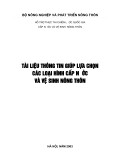
![Bài giảng Cấp nước và vệ sinh môi trường nông thôn [chuẩn nhất]](https://cdn.tailieu.vn/images/document/thumbnail/2025/20250522/phongtrongkim2025/135x160/406_bai-giang-cap-nuoc-va-ve-sinh-moi-truong-nong-thon.jpg)



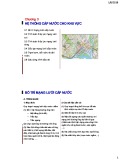
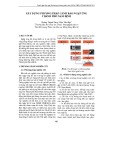
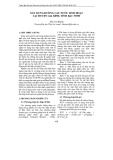




![Ô nhiễm không khí từ nông nghiệp: Thách thức toàn cầu và định hướng hành động [Mới nhất]](https://cdn.tailieu.vn/images/document/thumbnail/2025/20250917/kimphuong1001/135x160/52891758099584.jpg)







